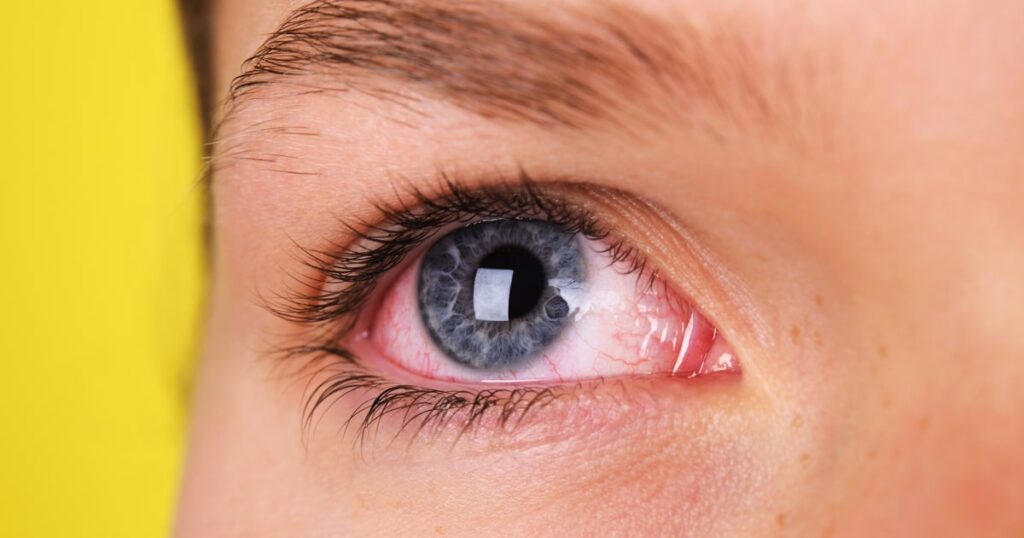One woman’s eyesight was so blurry she feared she was going blind. Another reported double vision that lasted for weeks. Yet another complained of floaters.
In all, five women who lived in different parts of southwest Michigan suddenly sought help for serious eye problems within weeks of each other.
The medical mystery led to a startling diagnosis: All of the patients had ocular syphilis, a complication of the sexually transmitted disease.
The cluster of cases shared a common link. It turned out the five women had sex with the same man who had syphilis, according to a case report published by the Centers for Disease Control and Prevention in November 2023. His illness was mostly asymptomatic and never affected his eyes.
Few people know syphilis can endanger vision, doctors say.
“Patients are very surprised, and most of the lay public doesn’t think of syphilis involving the eye,” Dr. Rahul Khurana, a spokesperson for the American Academy of Ophthalmology, tells TODAY.com.
“Untreated syphilis in the eye is devastating because it can lead to blindness.”
‘Syphilis crisis’
It’s especially concerning as syphilis cases surge in the U.S.
More than 207,000 Americans were diagnosed with the disease in 2022, an 80% increase since 2018 and the highest levels since the 1950s, the CDC reported in January 2024.
Cases were up in most every region and demographic group, including older people.
The U.S. Department of Health and Human Services called it a “syphilis crisis” and an “epidemic.”
Possible reasons why it’s happening include a rise in substance use, with alcohol and marijuana linked to more risky sexual behavior, Dr. Akshay Syal, a medical fellow with the NBC News Health and Medical Unit, told NBC News Now.
There’s also been a decrease in condom use and less funding for clinics where people can get tested for STDs, he added.
As the crisis unfolds, doctors are seeing more people in the U.S. hospitalized for syphilitic uveitis, or inflammation inside the eye and the most common ocular manifestation of syphilis, according to an investigation published in JAMA Ophthalmology in November 2023.
What causes ocular syphilis?
Syphilis is a sexually transmitted disease caused by a bacterium that invades blood vessels and could involve the central nervous system — when that happens, it can go into the brain and the eye, Khurana says.
The illness can lie hidden in the body only to cause symptoms later in time, so it’s often not caught early and people don’t realize that they have it, he adds. Some of his patients had no idea they were infected until they sought help for eye problems.
“We often call syphilis the great imitator because it looks like many other things,” says Khurana, who is ophthalmologist at Northern California Retina Vitreous Associates.
“Because it’s non-specific, it’s often missed by many ophthalmologists, and many people don’t even think about it.”
Besides causing blindness, untreated syphilis can seriously damage the heart and brain, and cause deafness and paralysis, the CDC warns.
What are the symptoms of ocular syphilis?
When syphilis affects the eyes, it usually causes inflammation inside them known as uveitis, Khurana says.
Eyes may be red, light sensitive or painful, he notes.
“Whenever I have a patient with uveitis, I always rule out everybody for syphilis just because it can present in so many different ways that you don’t want to miss it,” Khurana notes.
Syphilis accounts for 1% to 5% of cases of eye inflammation, according to the American Academy of Ophthalmology notes.
Other possible symptoms of ocular syphilis include floaters, blurry vision or even blindness, the CDC warns.
A blood test can confirm if a patient has syphilis.
What is the treatment?
If there’s a positive test, it’s important for the patient to see an infectious disease doctor because when syphilis involves the eyes, it’s also potentially involved in the brain, Khurana says.
Patients are treated with an intravenous antibiotic for 10 to 14 days and usually respond well, he notes. They may also get anti-inflammatory medicine to take care of the eye inflammation.
“If these things are caught early and treated early, patients could do very well,” Khurana says. “The challenge with syphilis is that often (doctors) don’t think about it, and so the diagnosis is often delayed.”
He urges eye doctors to have a “high index of suspicion” and rule out syphilis when patients show up with eye inflammation.
Treatment may not undo any damage caused by the infection, the CDC warns.
Using condoms every time you have sex can reduce the risk of getting syphilis, the agency notes.
Always get checked for any vision problems to rule out eye syphilis or other sexually transmitted diseases. STDs such as herpes and gonorrhea can also harm the eyes, according to the American Academy of Ophthalmology.
“With the incidence of STDs and syphilis on the rise in the community, I think everyone should be aware of it,” Khurana says.
Read the full article here











